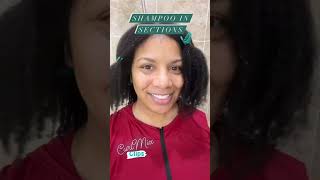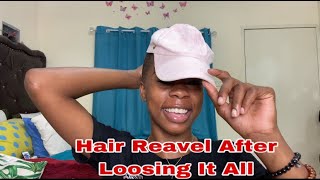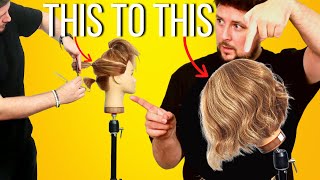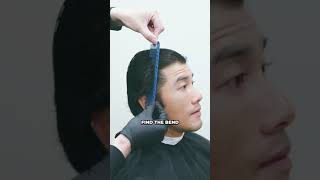How To Cut An Undercut Pixie Haircut Tutorial By Ben Brown
- Posted on 15 October, 2021
- Pixie
- By Anonymous
for the full length tutorial or information on a subscription to our site visit www.bbeducationuk.co.uk/online-educati...
disclaimer // these tutorials are meant for professional not for you to cut your own hair
Hello and welcome to this bb education cutting tutorial. Today'S tutorial is looking at an undercut pixie with maintaining length with the top veil, but creating a short uniform feel to the underneath, with our underneath shape. We have disconnected all the external shape to give a softer more textured feel our section is put into a c-curve going slightly narrower towards the occipital bone. Soft we're going to start this haircut at the side with a round graduation technique. We start with a diagonal back section: that's working relatively close to the vertical, giving us a softer shape and we pull it parallel to the head shape. This will give us a more uniform feel. We call this for working round as we're working parallel to the head shape this as it falls, will not distribute any weight or length. It will just maintain the same and fall quite layered. The bottom part of the section is pulled parallel out and is working flat. So as we're working flat here, we are going to build length towards the bottom. So this means that, as we are looking to have a disconnected shape, it's going to be much more blended by having the bottom of our section relatively layered. What we're looking to achieve with our horizontal shape is that both all the lengths traveling side to side stay the same. So, let's go through that. We'Re not wanting the length to get longer towards the back or shorter, so to keep the lengths the same out over direction is going to be meeting each section in the middle, helping us to control and ensure that we don't increase or decrease in length traveling horizontally. So, as we take section three we're going to remove section one, this is to ensure we get a lot more control of where our guideline will be. As we've stated, it's got to be in between section two and section three, so it has to be the equal distance between both bases. As we find this we'll pull our sections out slightly lifted at the top due to the head shape. Then we keep our line flat towards the ear we disconnect certain portion, roughly a centimeter of the external shape. We maintain this working through the next few sections. As our sections expand into the back you'll notice, the sections become much bigger. We'Re still going to maintain exactly the same process of working vertically flat, but the first section, as you can see here, is working flat to the head, which is giving us a more uniform, feel. Remember. It won't build any weight as we come down into the nape. Remember we're leaving out some of this hair to ensure we can control our client's hairline or create a visual effect. So we can either do this for an aesthetic or for a practical purpose. If your client has a really difficult hairline, you need to control it. It'S a great method, if your clients, if it's just an aesthetical reason, this is also going to help you. We need to cross-check our work, of course after every few sections and ensure that the shape traveling side to side is round. This means it will be quite curved in appearance and not flat, we're going to now work on the same methods on all of our subsequent sections. So now we've come to all the disconnection. For this part, i'm going to put down my scissors and pick up my feathered razor. The razor is a great tool for helping us to detail and design softer external lengths. While the scissors will give us a more definite result, the razor can be used to create more softness here, i'm using a shallow cutting technique to remove length. I start to visually analyze my shape and remove areas of weight and remove areas of thickness, see as we come to our final sections, there's hardly any hair to take off. So you can start to see how the weight is traveling around the curvature of the head. Creating softness now we need to go through with our razor again and start to detail in the external shape to our preferences. We use a shallow cutting technique to remove the length and then we can work through using the mirror, if necessary, to decide on what to do. Regards the texture with this side. Here we're pulling it slightly forward and creating a more jagged feel as it felt quite heavy we're not going to wrap dry the hair, getting full control of all the roots areas. So we can assess our haircut. We can check it. We can check the balance and we can assess the levels of texture needed to create the correct end result. You can start to see by moving the hair and playing with the hair, how the haircut is sitting and which bits are great and which bits need to be more worked on. So here we have the undercut complete. Now i can move on to the top section, which means we're going to start at the back of our c curve. It'S important to remiss the hair, as the hair may have been tied up for a good 20 to 30 minutes, so remix it and form a central vertical profile section. This vertical section is going to be the start of how we blend in our undercut. Remember all undercuts will have some disconnection, but it's important to have a visual connection, we're going to start with our layers. I'Ve chosen for my internal shape to be relatively layered, but still maintain the graduated feel. So i need to build a corner. So i'm working vertically square by working vertically square, i'm going to be short at the top of my section, going to longer i'm building a corner as the head rounds. So all my subsequent sections are going to be pulled up and cut to this level. So that's the elevation. The elevation is pulled directly up to be parallel to the ceiling, so my cut line is parallel to the floor or parallel to the ceiling. Let'S discuss the shape that now travels side to side, keeping all our sections parallel section two will now be over directed onto the base of section one. This is giving us a small and incremental increase with each section. So once we've completed this section, we remove the previous, and then we take section three and section three will be over directed to this is repeated as it gives us a small increase of length traveling towards behind the ear what's been achieved. Is we have our layer, but the length may be still too long? It may be that you like the length at this point and you can keep it. That'S absolutely fine. What happens if your client wants it shorter, retake your vertical profile and pull your section straight out this time, we're going to work vertically triangular, utilizing the length from our top vertically square shape as a guide, so we're taking the shorter point from the length we cut Vertically, as a guideline and we're connecting in triangular, which helps us to decrease the length, as we cross check, you can see, our line is flat, which is giving us a slow increase of length, traveling side to side, take a vertically profile section and then we're going To give ourselves a guideline on how we're going to cut the top, all our sections are cut flat with exception, the very front. What you'll notice is that, as i come through the apex into the front zone, my sections are starting to be pulled over slightly. So i'm utilizing over direction. Why do you think this is it's to increase the length traveling forward, so i'm utilizing every direction here to find a guideline to ensure that we don't go too short at the front. We now work horizontal. All our sections are pulled directly up of their own base, utilizing the profile section as a guide they're all cut flat, which again is about keeping that corner the corner will give us the illusion of graduation, even though this is in fact a layered shape. Our body position must be square to the sections, we're cutting to assess, there's no other direction, and there is only the elevation working parallel to the ceiling. All the sections are cut off their own base as we're utilizing the profile section as a guideline once complete, we start to let the hair breathe grooming, the hair into the position, so we're going to start by working straight out from the head, i'm just going to Work some parallel point cutting, which is the least impactful form of texturizing. You





Comments
Yolanda María Martín: Precioso
ewa cierzniakowska: Exelent work Could you tell me please,what's name of your scissors please?
Courtney Gulley: Where do you get your mannequin heads? I use pivot point but would like some more affordable for the sake of trying new haircuts
Shaya Houle: Very nice scene man and very well explain your video have great contence
Maryam Sani: As always Excellent
Lu Bijoux Creazioni: Please, I’m not an hairdresser, but I need to cut my mom’s hair because she is sick, so, How could I make a vero easy cut ? Thanks so much
Na Alj: Luv your work i wil deff. try this